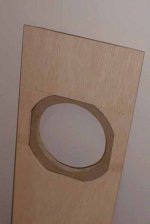Hi guys,
I'm planning to build myself a center channel this summer, and unfortunately a router is not in my budget (I'm a poor college student). I was wondering if its possible (and a good idea) to use a sort of faceplate with holes cut out for the drivers that would essentially make my speakers flush mounted. I've read something about doing this with wood, but what about some sort of foam, or maybe plastic? I'm looking for something that I could perhaps cut with a knife, or maybe even a dremmel tool.
Would this work well? and if so what would be a recommended material?
Thanks
I'm planning to build myself a center channel this summer, and unfortunately a router is not in my budget (I'm a poor college student). I was wondering if its possible (and a good idea) to use a sort of faceplate with holes cut out for the drivers that would essentially make my speakers flush mounted. I've read something about doing this with wood, but what about some sort of foam, or maybe plastic? I'm looking for something that I could perhaps cut with a knife, or maybe even a dremmel tool.
Would this work well? and if so what would be a recommended material?
Thanks
Thanks for both of your advice. It's good to know that I might be able to actually pull this off with somewhat of a minumum on tools.
To anyone whos tried any of the mentioned methods, what are the benefits of the different materials. ie. felt was mentioned and would probably damp any sound hitting the front of the enclosure, but wood was also mentioned which would be much more reflective. Anyway, just trying to learn, so if anyone has a link that they think might be useful that would be much appreciated as well.
Thanks,
Chris
PS. dinamic, you're right, a picture was definately worth more than words. Thanks
To anyone whos tried any of the mentioned methods, what are the benefits of the different materials. ie. felt was mentioned and would probably damp any sound hitting the front of the enclosure, but wood was also mentioned which would be much more reflective. Anyway, just trying to learn, so if anyone has a link that they think might be useful that would be much appreciated as well.
Thanks,
Chris
PS. dinamic, you're right, a picture was definately worth more than words. Thanks
Poly-bendium
Westlake Audio, a very well respected pro-audio company uses closed cell foam as "wings" around some of their smaller studio monitors (emulating soffit mountings) to reduce diffraction effects. You should be able to use this detail to accomplish your goal with very little effort.
Cyclotronguy
Westlake Audio, a very well respected pro-audio company uses closed cell foam as "wings" around some of their smaller studio monitors (emulating soffit mountings) to reduce diffraction effects. You should be able to use this detail to accomplish your goal with very little effort.
Cyclotronguy
I have used felt, neoprene, laminated boards, and countersinking. My advice is to go with felt. It is easy to cut, gives you some room for error, and to boot it sounds great, especially with teeters and mids.
Sorry I don't have a link for you,
Digi
Sorry I don't have a link for you,
Digi
Only use foam if you have already rebated the driver otherwise an uneven response will still result from the edge difraction off the driver flange, especially circular ones. With rectangular flanges it is less severe but there none the less. Felt as stated by others is very effective and easy to do otherwise use the methods suggested by others which has the added benefit of laminating the baffle and hence distributing and absorbing unwanted resonances especially if you use a lossy contact type adhesive.
tomcat🙂
tomcat🙂
my recent project with felt
you are welcome to have a look at a recent set of speakers i built (an implementation of the bipolar transmission line TL_B using RS 40-1354A) --see link below--.
in this construction, i started out meaning to use felt as a means of flush mounting, but ended up not using it that way - the RS 40-1354A already has enough of a weird cardboard rim around the mounting flange.
however, using felt all around did save me quite a bit of sanding/painting hassles! just sanded down all the MDF surfaces coarsely, sprayed with 3M Super 77 adhesive, and the felt went on like a charm. this adhesive is available at home depot etc, and is commonly used among DIY pool table makers to glue felt permanently to wood.
http://web.mit.edu/~sarin/www/tlb.html
you are welcome to have a look at a recent set of speakers i built (an implementation of the bipolar transmission line TL_B using RS 40-1354A) --see link below--.
in this construction, i started out meaning to use felt as a means of flush mounting, but ended up not using it that way - the RS 40-1354A already has enough of a weird cardboard rim around the mounting flange.
however, using felt all around did save me quite a bit of sanding/painting hassles! just sanded down all the MDF surfaces coarsely, sprayed with 3M Super 77 adhesive, and the felt went on like a charm. this adhesive is available at home depot etc, and is commonly used among DIY pool table makers to glue felt permanently to wood.
http://web.mit.edu/~sarin/www/tlb.html
- Status
- Not open for further replies.
- Home
- Loudspeakers
- Multi-Way
- substitute for flush mounting
